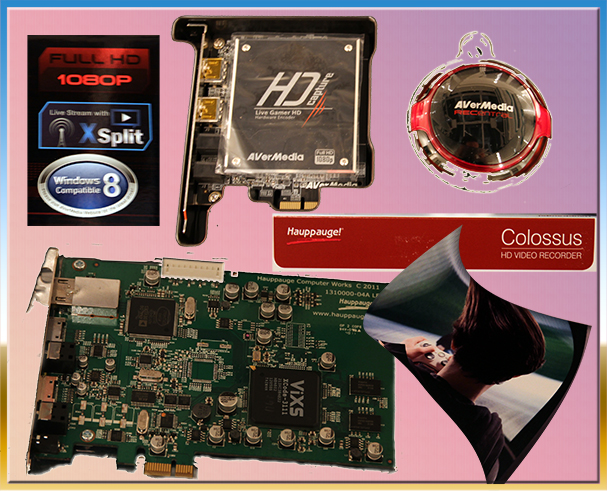A Captivating Experience.
Hauppauge Colossus and Avermedia Live Gamer HD
The editorial decision to pair up these tasty contenders stems from the fact that their originators shared a similar history and philosophy. Both were initially established as prolific manufacturers of PC components designed to receive worldwide Television, Cable and Satellite broadcasts and excelled in the art marrying high-end functionality with prices the average consumer’s pockets could tolerate without the risk of a small fire
Moreover, these are the only two hardware products under scrutiny that were engineered and promoted to serve a game recordist’s precise needs.
Taiwanese based Avermedia, the youngest of the companies we have discussed, turned their attention to the gaming market in late 2011 with the release of their external “Game Capture HD”, a self governing PVR aimed squarely at the console crowd, this was swiftly followed by the Game Broadcaster HD, an internal PCI-E card with VGA, component and HDMI inputs that allowed for online streaming in addition to video capture.
The Live Gamer HD swaggered out within months and, save for the absence of analogue inputs, combined all the assets of the Broadcaster with hardware assisted H.264 encoding.
Considerably longer in the tooth, it was Hauppauge who in 2008, first realized the dreams of the High Definition archivist with its innovative “HD-PVR”, another outboard USB 2.0 device that represented sensational value at the time of its release and for several years thereafter.
Hauppauge Colossus Crysis Test
Get the Flash Player to see this player.The “Colossus” examined here, was an internal PCI-E variant that played host to identical traits, but added an HDMI input to the mix and boosted the maximum capture rate from 13 to 20MBPS. Like the Live Gamer, it alleviated the CPUs workload with a onboard encoding chip.
In contrast to Avermedia’s in-house developed “Rec Central” application, activated by a giant red button the Colossus’s supplied software, “Total Media Showbiz”, was not devised by Hauppauge themselves, but came from third party Arcsoft.
Both interfaces were accessible and practical, even if their features were rather sparse. Rec Central was better attuned to the PC gamer, with intuitive options for live streaming, recording on a secondary computer and assignable shortcut keys while Showbiz featured built-in file editing and disc authoring functions.

Recordings with each were once again made in the H.264 format with Showbiz presenting a choice of three containers (TS, MP4 and M2TS) for those wishing to immediately replay their footage on an XBOX 360 or PS3.




